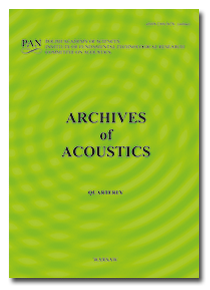Archives of Acoustics,
37, 3, pp. 287–294, 2012
Theoretical Studies of Nonlinear Generation Efficiency in a Bubble Layer
The aim of the paper is a theoretical analysis of propagation of high-intensity acoustic waves throughout
a bubble layer. A simple model in the form of a layer with uniformly distributed mono-size spherical
bubbles is considered. The mathematical model of the pressure wave’s propagation in a bubbly liquid
layer is constructed using the linear non-dissipative wave equation and assuming that oscillations of
a single bubble satisfy the Rayleigh-Plesset equation. The models of the phase sound speed, changes of
resonant frequency of bubbles and damping coefficients in a bubbly liquid are compared and discussed. The
relations between transmitted and reflected waves and their second harmonic amplitudes are analyzed.
A numerical analysis is carried out for different environmental parameters such as layer thicknesses and
values of the volume fraction as well as for different parameters of generated signals. Examples of results
of the numerical modeling are presented.
a bubble layer. A simple model in the form of a layer with uniformly distributed mono-size spherical
bubbles is considered. The mathematical model of the pressure wave’s propagation in a bubbly liquid
layer is constructed using the linear non-dissipative wave equation and assuming that oscillations of
a single bubble satisfy the Rayleigh-Plesset equation. The models of the phase sound speed, changes of
resonant frequency of bubbles and damping coefficients in a bubbly liquid are compared and discussed. The
relations between transmitted and reflected waves and their second harmonic amplitudes are analyzed.
A numerical analysis is carried out for different environmental parameters such as layer thicknesses and
values of the volume fraction as well as for different parameters of generated signals. Examples of results
of the numerical modeling are presented.
Keywords:
nonlinear acoustics; bubble layer; transmitted and reflected waves
Full Text:
PDF
Copyright © Polish Academy of Sciences & Institute of Fundamental Technological Research (IPPT PAN).





